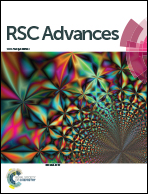Preparation and performance studies of polysulfone-sulfated nano-titania (S-TiO2) nanofiltration membranes for dye removal†
Abstract
Polysulfone nanofiltration membranes containing sulfated nano-titania (S-TiO2) were fabricated, with the aim to enhance the membrane properties along with the possible rejection of Methylene Blue (MB) dye by membranes. Initially S-TiO2 was synthesized from nano TiO2 by the action of sulfuric acid. The synthesized S-TiO2 was characterized by Fourier Transform Infrared spectroscopy (FT-IR), Energy Dispersive Spectrophotometry (EDS) and Transmission Electron Microscopy (TEM) analysis. S-TiO2 was added in increasing concentrations into the membranes and its effect on the performance of the membranes was evaluated. The synthesized membranes were characterized by Scanning Electron Microscopy (SEM) and Atomic Force Microscopy (AFM). Polysulfone membranes containing S-TiO2 showed enhancement in properties in terms of hydrophilicity, water uptake, mechanical strength, improved pure water flux (PWF), antifouling nature and high Flux Recovery Ratio (FRR). The polysulfone membranes with S-TiO2 showed 99% rejection for BSA (Bovine Serum Albumin) protein molecules during BSA filtration. The prepared membranes were used for the removal of MB dye from aqueous solutions. A maximum of 90.4% rejection was obtained for MB for the membrane having 2.0 wt% of S-TiO2 under UV light radiation. This approach showed that polysulfone-S-TiO2 membranes displayed good efficiency for dye removal and can be effectively used for the removal of MB dye from aqueous solutions under suitable conditions.


 Please wait while we load your content...
Please wait while we load your content...